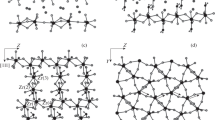Abstract
The effect of the anion charge on the structure of [LiAl2(OH)6]nX (X = Cl-, Br-, I-, SO4 2-, C6H8O4 2-) intercalation compounds and the water effect on the structure of [LiAl2(OH)6]Cl·nH2O have been studied using 1H, 7Li, and 27Al NMR. A change in the charge on the anion leads to significant changes in the asymmetry parameter for the lithium and aluminum nuclei with relatively small changes in the quadrupolar coupling constant and the broadening factor. The structure of the intermediate [LiAl2(OH)6]Cl·0.5H2O hydrate can be represented as a derivative of the structure of the anhydrous [LiAl2(OH)6]Cl intercalate with a slightly increased layer thickness and a minor orthorhombic distortion of the hexagonal cell; the water molecules partially fill the interlayer voids and participate in the diffusion process. Further hydration of the intercalate (x ≥ 1) leads to a minor (0.2Å) increase in the layer thickness and is accompanied by disordering of chloride ions and water molecules in the interlayer space.
Similar content being viewed by others
REFERENCES
V. P. Isupov, N. P. Kotsupalo, A. P. Nemudry, and L. T. Menzeres, “Aluminum hydroxide as selective sorbent of lithium salts from brines and technical solutions,” in: A. Dabrowski (ed.), Adsorption and Its Applications in Industry and Environmental Protection. Studies in Surface and Catalysis 120, Elsevier, Amsterdam (1999), pp. 621-652.
V. P. Isupov, “Intercalation compounds of aluminum hydroxide,” Doctoral Dissertation in Chem. Sci., Novosibirsk, Institute of Solid State Chemistry and Mechanochemistry, Siberian Branch, Russian Academy of Sciences (1998).
N. P. Kotsupalo, “Physicochemical principles underlying the production of selective sorbents and the process of lithium extraction from brines with utilization of the latter,” Doctoral Dissertation in Chem. Sci., Institute of Solid State Chemistry and Mechanochemistry, Siberian Branch, Russian Academy of Sciences, Novosibirsk (2000).
H. Saalfeld and M. Wedde, Z. Kristallogr., 139, 129-135 (1974).
F. Zigan, W. Joswig, and N. Burger, Z. Kristallogr., 148, 255-273 (1978).
H. J. Bosmans, Acta Crystallogr., B26, No.7, 649-652 (1970).
G. R. Clark, K. A. Rogers, and G. S. Henderson, Z. Kristallogr., 213, 96-100 (1998).
V. P. Isupov, A. P. Nemudry, N. P. Kotsupalo, and T. I. Samsonova, in: Chemistry and Technology of Rare and Nonferrous Metals and Their Salts, Abstracts of Papers, Frunze (1982), p. 336.
J. L. Burba, “Crystalline lithium aluminates,” U.S. Patent No. 4348295 (1983).
A. P. Nemudry, V. P. Isupov, N. P. Kotsupalo, and V. V. Boldyrev, React. Solids, 1, 221-226 (1986).
K. R. Poeppelmeier and S. J. Hwu, Inorg. Chem., 26, 3297-3302 (1987).
A. V. Besserguenev, A. M. Fogg, R. J. Francis, et al., Chem. Mater., No. 9, 241-247 (1997).
V. P. Isupov, S. P. Gabuda, S. G. Kozlova, and L. É. Chupakhina, Zh. Strukt. Khim., 39, No.3, 448-452 (1998).
A. M. Fogg, A. L. Rohl, G. M. Parkinson, and D. O'Hare, Chem. Mater., No. 11, 1194-1200 (1999).
S. G. Kozlova, S. P. Gabuda, V. P. Isupov, and L. É. Chupakhina, Zh. Strukt. Khim., 42, No.2, 231-235 (2001).
X. Hou and R. J. Kirkpatrick, Inorg. Chem., 40, No.25, 6397-6404 (2001).
A. P. Nemudry, V. P. Isupov, N. P. Kotsupalo, and V. V. Boldyrev, Izv. Sib. Otd. Akad. Nauk SSSR, Ser. Khim. Nauk, No. 11, 28-32 (1984).
V. P. Isupov and L. É. Chupakhina, Zh. Neorg. Khim., 43, No.1, 58-64 (1998).
S. E. Ashbrook, J. McManus, K. J. D. MacKenzie, and S. Wimperis, J. Phys. Chem. B, 104, 6408-6416 (2000).
V. P. Isupov, S. G. Kozlova, S. P. Gabuda, and L. É. Chupakhina, Dokl. Ross. Akad. Nauk, 355, No.6, 774-776 (1997).
A. Abragam, The Principles of Nuclear Magnetism, Oxford (1961).
S. P. Gabuda and A. F. Rzhavin, Nuclear Magnetic Resonance in Crystalline Hydrates and Hydrated Proteins [in Russian], Nauka, Novosibirsk (1978).
Author information
Authors and Affiliations
Rights and permissions
About this article
Cite this article
Kozlova, S.G., Gabuda, S.P., Isupov, V.P. et al. Using NMR in Structural Studies of Aluminum Hydroxide Intercalation Compounds with Lithium Salts. Journal of Structural Chemistry 44, 198–205 (2003). https://doi.org/10.1023/A:1025586321484
Issue Date:
DOI: https://doi.org/10.1023/A:1025586321484



